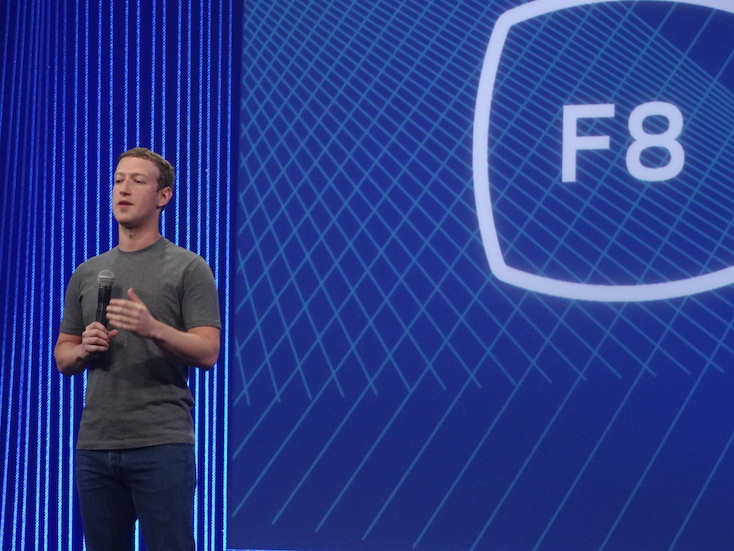 NEWS
NEWS
 NEWS
NEWS
 NEWS
NEWS
Facebook may still be a social network, but its not-too-distant future belongs squarely in two other forms of online interaction: messaging and live video.
That will become abundantly clear at the company’s F8 conference Tuesday and Wednesday in San Francisco, where it will encourage software developers and businesses to dive deeper into messaging and live video as the key ways to reach especially young consumers today.
The new focus comes amid recent reports that people are sharing fewer personal updates with each other. That’s raising concerns about Facebook’s ability to keep people engaged–either with each other or with the businesses that spent nearly $18 billion advertising on Facebook’s apps and site last year.
For one, Facebook is expected to announce new tools for making its Messenger app, which was broken off from the main app less than two years ago, more useful to businesses and their customers. It may offer easier ways for businesses to connect to customers for enabling customer service or shopping.
In particular, Facebook looks likely to announce plans to make it easier to create bots, or small programs to automate tasks. On Tuesday, the company is expected to announce support for chatbots, which are programs that enable people to engage in text conversation to order from Taco Bell or call an Uber, for instance.
According to several companies familiar with its plans, it appears likely that Facebook will announce at least the intention to create a “bot store” akin to Apple’s and Google’s app stores. The potential is for bots to become a new kind of platform that could work better for commerce than today’s plethora of mostly disconnected apps. In other words, Facebook aims to make bots better apps than those on iOS and Android.
Bots have already caught on among young users of messaging apps such as Kik (Kik Interactive, Inc.) and China’s WeChat (Tencent, Inc.). And now, brands and marketers are starting to get excited about a new way to reach consumers beyond the ads that more and more of them are blocking before they’re seen.
“We’re seeing a lot of interest already,” David Hewitt, a vice president who heads mobile strategy at the digital ad agency SapientNitro, said in an interview. “Those behaviors haven’t come over the pond to the U.S. yet, but I think they will.”
Hewitt hopes Facebook will enable, for instance, ads in the news feed to open up into Messenger conversations. That could lead to all kinds of interactions, but e-commerce could be the big one, he said. Beauty retailer Sephora recently launched a bot on Kik that allows customers to shop for makeup.
Hewitt thinks chatbots are just the start, though. He thinks bots will start to interact with each other to carry out more complex requests, with services such as Apple’s Siri serving as orchestra conductors for collections of bots. “Bots are the first practical step toward artificial intelligence.”
No doubt Facebook, which has invested heavily in AI, doesn’t think chatbots are the endgame either. Matt Idema, Facebook’s vice president of monetization product marketing, said in an interview that the company realizes that people are in a different mindset in messaging than in the news feed. Marketing in messaging, he said, “may look very different from other marketing.”
The other big focus at F8 will be video–in particular live video. Last week, Facebook announced a raft of new features for its Live video service, including the ability for users to share live broadcasts with specific groups of people or events.
In a sense, Live is also a form of messaging, at least judging from Chief Executive Mark Zuckerberg’s own 15-minute live video last week. In it, he pointed out several examples of what he considered compelling live videos, including video of a woman skiing with her kids and another of bald eagle chicks, that suggest a form of messaging that happens to be video instead of text.
Yet they also suggest the potential for a separate platform for businesses to reach consumers. Although live video is hardly a new phenomenon, it has accelerated recently with video apps such as Twitter Inc.’s Periscope. The entry of a behemoth like Facebook could make it mainstream in one fell swoop.
“We want to get more reach, and that’s what Facebook can provide,” said Andy Smith, founder and CEO of Daily Burn, which has been testing its “365” live workout subscription service on Facebook Live.
One big question, though, is to what extent Facebook Live will accommodate more professionally produced video such as Daily Burn’s, not just video done casually on a smartphone. “We’d like to feed our production-quality feeds into Live,” said Smith, who noted that YouTube can accept high-quality video. “We can’t get the essence of that with an iPhone.”
Taken together, Facebook’s moves at F8 suggest a new era for companies aiming to connect with consumers in ways that more closely match a new media landscape driven mainly by mobile devices. “As TV starts to decline, the mobile screen has become the most important screen for brands to tell their stories,” Harry Kargman, founder and CEO of the digital ad technology firm Kargo, said in an interview.
Support our mission to keep content open and free by engaging with theCUBE community. Join theCUBE’s Alumni Trust Network, where technology leaders connect, share intelligence and create opportunities.
Founded by tech visionaries John Furrier and Dave Vellante, SiliconANGLE Media has built a dynamic ecosystem of industry-leading digital media brands that reach 15+ million elite tech professionals. Our new proprietary theCUBE AI Video Cloud is breaking ground in audience interaction, leveraging theCUBEai.com neural network to help technology companies make data-driven decisions and stay at the forefront of industry conversations.